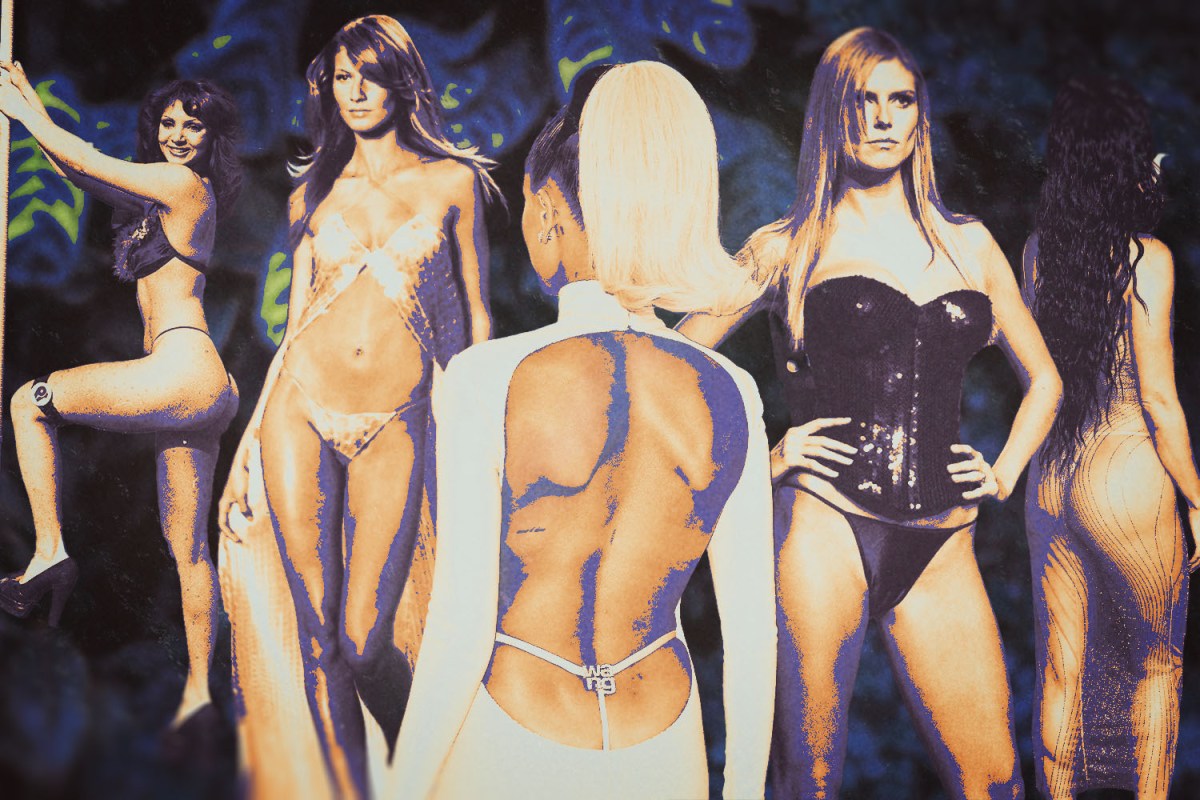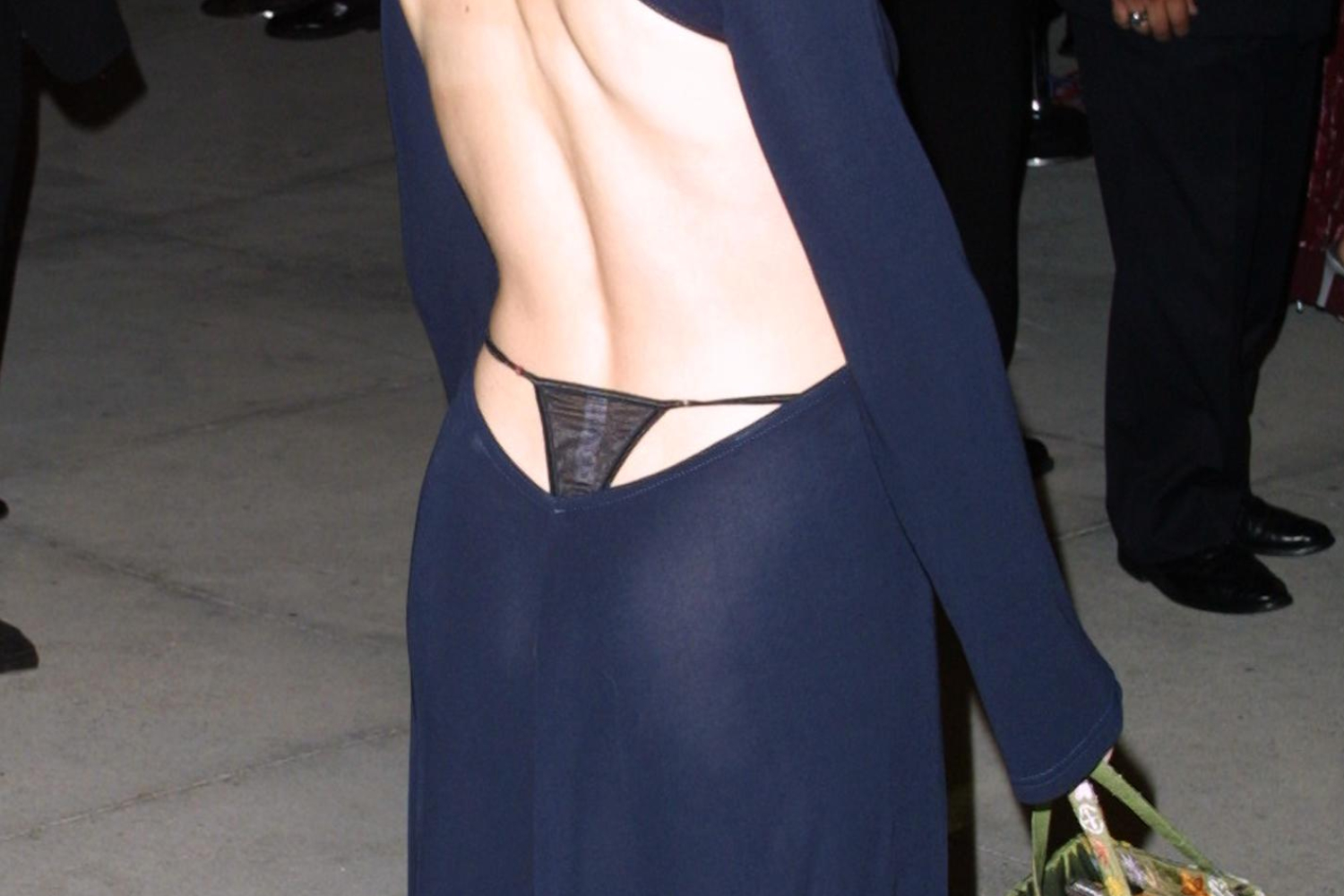These days, you don’t have to look too far on any given red carpet to see a G-string baring the backside of some A-list starlet or other, usually sparkling beneath a sheer designer garment or peeking out above an ultra low-back dress. But before the G-string was de rigueur evening wear for Hollywood elites, it was a risqué, oft-policed garment reserved exclusively for strippers and burlesque performers. If the mainstream stars flaunting their G-strings at awards shows today still manage to turn heads for their racy yet increasingly common displays of rear cleavage (and of course they do) it’s thanks largely to the sex industry workers and performers before them who made the G-string the ultimate erotic undergarment.
Jo Weldon, Headmistress of the New York School of Burlesque and author of The Burlesque Handbook and Fierce: The History of Leopard Print, recently detailed the history of the G-String in the Morbid Anatomy lecture, “The Ultimate Triangle: An Illustrated History of the G-String.” Part of her ongoing anthology of sex industry fashion, Sex Worker Style, Weldon’s lecture traces the G-string’s origins in cultures of antiquity, through the eroticization of the exotic as the G-string was introduced to the Western world by the stripteasers and showgirls of the early 20th century, to the garment’s eventual role as an underwear drawer staple/red carpet fashion statement after the “stripper chic” aesthetic went mainstream ahead of the new millennium.
The Secret to Hitting the G-Spot Is… Pressing Down on Her Stomach?
We spoke with a sex therapist to find out if this viral sex hack is legitThroughout its various incarnations, the G-string — at least in Western culture — has always been something of an inherent contradiction: a garment meant to be seen and unseen, to cover yet expose. Many women wearing G-strings today do so simply to avoid the sartorial sin of visible panty lines, donning the oft-eroticized garment beneath jeans or leggings to go to work or hit the gym or carry out various other mundane responsibilities of everyday life. But if we’re getting ready for a date, the G-string serves a dual purpose: it won’t show beneath a little back dress, but it will look sexy once that dress comes off. For performers who strip down to G-strings on stage or celebrities who show them off under sheer couture, the G-string is as much about showing skin as it is covering it. It toes the line between nakedness and coverage, between exposure and censorship.
In untangling the G-string’s perhaps surprisingly rich history and reputation, Weldon taught us a few things your average wearer (or admirer) of women’s undergarments may not know about fashion’s sexiest underwear.
A G-string is not the same thing as a thong
First, let’s get clear on what we’re talking about here. While we might consider the G-string a subcategory of the thong (and the terms are sometimes used interchangeably) they’re different things. While both are composed of the same basic elements — a triangle of fabric in the front that narrows to a thinner strip in the back, all connected by a waistband — a G-string is, well, stringier. G-strings have a thinner strip in the back than thongs, and typically thinner waistbands as well.
No one really knows what the “G” in “G-string” stands for
According to Weldon, no one is entirely sure of the etymological origins of the “G-string.” There’s some reason to believe that the “G” might stand for “groin,” but other prominent theories suggest the “G” spelling actually evolved from an earlier spelling, “geestring,” and refers to a violin string tuned to a G. Merriam Webster’s current definition labels the word’s etymology “unknown.”
Roland Barthes called the G-string “the ultimate triangle”
While literary buffs may best know Roland Barthes for introducing concepts like “The Death of the Author” to literary theory, the French critic and philosopher also had a few thoughts on G-strings. In the essay “Striptease” from his 1957 collection, Mythologies, Barthes declared the G-string, “the ultimate triangle,” (from which Weldon’s lecture gets its name), one that “bars the way to the sexual parts like a sword of purity.”
Strippers’ G-strings were (and still are) routinely policed by authorities
According to Weldon, whose knowledge is largely informed by her own background as a stripper, the amount of skin women could show on stage in strip clubs was heavily regulated, and those regulations varied significantly from state to state, county to county and club to club. These regulations, as Weldon notes, were typically determined by liquor boards rather than the state, which is why they could shift dramatically within a relatively short distance. “I’ve been in cities where I could cross the street, be in a different county and be required to wear different costumes,” she wrote in a 2020 Instagram post.
These regulations could dictate everything from how wide the straps on a stripper’s G-string had to be, to whether she was allowed to bend over while wearing one and how much pubic hair she was permitted, or required, to show. According to Weldon, while these regulations were ever-changing, (which only made it harder for performers to remain compliant with the law) they do remain in place, to some extent, in many parts of the country. Of course, they’re not always enforced, but they certainly can be, and have been.
Charles Guyette was the “G-String King”
20th-century fetishwear icon Charles Guyette was literally known as the “G-string King.” Often credited as the first person in America to produce and distribute fetish art, Guyette was also a prominent burlesque costumer who provided corsets, gloves and, of course, G-strings to performers. One of pornography’s many martyrs, Guyette eventually did time for his contributions to fetish art, landing in federal prison in 1935.
And Gypsy Rose Lee was the queen
If Guyette was the G-string king, then burlesque star Gypsy Rose Lee was the queen. One of the most famous burlesque performers of the 20th century, Gypsy Rose was perhaps the most iconic of the strip-teasers responsible for making the G-string the erotic garment it is today. The star even published a work of fiction called The G-String Murders in 1941, and Lee’s own son referred to her as his “G-String Mother” in his memoir.

Victoria’s Secret is largely responsible for making the G-string (or V-string) mainstream, everyday wear
These days, G-strings aren’t the exclusive domain of strippers or celebrities, but can regularly be found flossing the buttcheeks of regular, everyday women just trying to avoid panty lines. For this, we have Victoria’s Secret to thank. While brands like Fredericks of Hollywood and Hanky Panky brought G-strings further from erotic novelty and closer to your average mall-shopper, Victoria’s Secret was the first to make the G-string an everyday, must-have undergarment for the average woman. The brand trademarked its iconic “V-string” panty in 1998, marketing the garment as the supermodel’s secret to everyday sexiness, with not a panty line in sight.
Whether you’re looking to get into shape, or just get out of a funk, The Charge has got you covered. Sign up for our new wellness newsletter today.



























